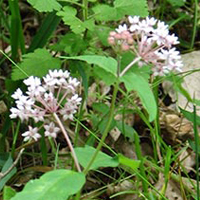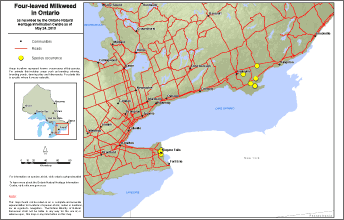Four-leaved milkweed
Scientific name: Asclepias quadrifolia

Cover photo credit: Sean Blaney
Status
Endangered
“Endangered” means the species lives in the wild in Ontario but is facing imminent extinction or extirpation.
Date added to the Species at Risk in Ontario List
September 28, 2010
Read the Assessment Report
What it looks like
The Four-leaved Milkweed is a leafy, perennial plant, one of the smallest of the North American representatives of the milkweed genus. It grows 20 to 80 centimetres tall. Four-leaved Milkweed has leaves that are arranged in opposite pairs, and has clusters of small, pinkish-white flowers.
This plant flowers from late May till the end of June. Pollination is mostly by bees and butterflies. Seeds have dense tufts of silky white hairs to aid in wind dispersal, and are contained in long, narrow seed pods on mature plants.
Where it lives
Four-leaved Milkweed typically occurs on dry to somewhat moist, shallow or rocky soils over limestone, or sometimes sandstone, bedrock within mature deciduous woodlands and sometimes in forests, thickets or meadows.
In Ontario, it is found in two types of habitat: (1) dry woodlands dominated by Tallgrass prairie herbs, Bur Oak and Shagbark Hickory, and (2) a woodland alvar dominated by Red Cedar and pasture grasses, which was probably created by human activities.
Where it’s been found in Ontario
Four-leaved Milkweed is at the northern limit of its range in Ontario and New England.
There are only two known populations remaining in Ontario, both in Prince Edward County.
Historically, populations have also been recorded from the neighbouring Lennox and Addington County, as well as from the Niagara River gorge.
View a Larger version of this map (PDF)
What threatens it
Threats to the remaining populations of Four-leaved Milkweed in Ontario include habitat loss due to residential and agriculture land uses, and invasive plant species
Action we are taking
Endangered Species and their habitat are automatically protected
Recovery strategy
A recovery strategy advises the ministry on ways to ensure healthy numbers of the species return to Ontario.
Read the executive summary (December 7, 2011)
Read the recovery strategy (December 7, 2011)
Government response statement
A government response statement outlines the actions the government intends to take or support to help recover the species.
Read the government response statement (September 7, 2012)
Five-year review of progress
A five-year review of progress made toward protecting and recovering a species is required no later than five years after the government response statement for that species is published.
Read the report on progress towards the protection and recovery of six species at risk, including Four-leaved Milkweed (2017).
Habitat protection
A habitat regulation defines a species' habitat and many describe features (e.g., a creek, cliff, or beach), geographic boundaries or other unique characteristics.
Read the habitat summary (January 1, 2014)
What you can do
Report a sighting
- Report a sighting of an endangered animal or plant to the Natural Heritage Information Centre. Photographs with specific locations or mapping coordinates are always helpful.
Volunteer
- Volunteer with your local nature club or provincial park to participate in surveys or stewardship work focused on species at risk.
Be a good steward
- Private land owners have a very important role to play in species recovery. If you find Four-leaved milkweed on your land, you may be eligible for stewardship programs that support the protection and recovery of species at risk and their habitats.
- Invasive species seriously threaten many of Ontario’s species at risk. To learn what you can do to help reduce the threat of invasive species, visit:
www.ontario.ca/invasivespecies
www.invadingspecies.com
www.ontarioinvasiveplants.ca - Four-leaved Milkweed are pollinated by bees and butterflies. Pollinators are in steep decline across the globe and they play a key role in the survival of many of Ontario’s rare plants. For information on how you can help scientists monitor pollinator populations in Ontario visit:
www.seeds.ca/proj/poll.
Report illegal activity
- Report any illegal activity related to plants and wildlife to
1-877-TIP-SMNR (847-7667) .
Quick facts
- The milkweed family gets its name from its milky juice.
- The scientific name for the milkweed genus, Asclepias, is taken from Asclepius, the Greek god of healing, because of the many folk-medicinal uses for milkweed plants.
- The two populations of Four-leaved Milkweed which are known to still exist in Ontario were only recently discovered – in 2006 and 2007. It is possible that additional populations may be identified in the future.
